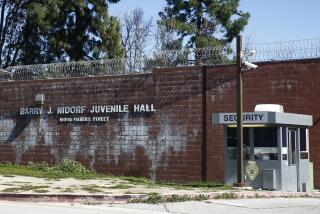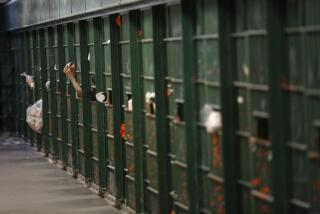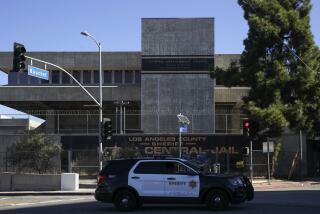Editorial: To build, or not to build, a new L.A. County jail
“There is no way you can have effective treatment inside of a jail,” Mark-Anthony Johnson tells a crowd of cheering activists. “It is not possible.”
Hundreds of people pack the Hollywood United Methodist Church on this blustery January evening to hear from Johnson and other leaders of JusticeLA, a group formed to fight what members are calling the planned expansion of the Los Angeles County jail system. It is a battle that has been brewing in one form or another for at least a decade as county officials have sought to tear down the decrepit and dangerous Men’s Central Jail in downtown L.A. and replace it with a more modern facility, designed around the treatment needs of mentally ill inmates. It is to be known as the Consolidated Correctional Treatment Facility — but of course it is still a jail.
The $2.2-billion project also includes the repurposing of the Mira Loma Detention Center in Lancaster as a women’s jail to replace the current facility in Lynwood. The Board of Supervisors faces a key vote Tuesday on moving the project forward.
The challenge of the county’s mentally ill population is at the center of the fight over the project. Perhaps 40% of L.A. jail inmates suffer from moderate to serious mental illness, and the figure jumps to 70% when you include inmates with serious medical problems. The Los Angeles County jail system is in effect the nation’s largest mental hospital.
Enter the Fray: First takes on the news of the minute from L.A. Times Opinion »
The project is opposed by activists who organized around the mistreatment of family members and neighbors in the L.A. jails and who successfully pushed for the creation of a civilian oversight commission to keep a watchful eye on the Sheriff’s Department and by others who see over-incarceration as one part of a system that also includes the over-policing and over-surveillance of African American and Latino communities.
Last year, JusticeLA’s message was amplified after the group received a $1-million grant from the Open Philanthropy Project, which is backed by Good Ventures — a foundation created and funded by Dustin Moskovitz, one of the four founders of Facebook.
The Hollywood event is one of five town hall meetings — one in each county supervisor’s district — to rally opposition to the project, which activists say would divert up to $3.5 billion (a figure they say accounts for typical cost overruns) that could better be spent on housing, education and other programs that help people from spiraling into addiction or mental illness.
Why, Johnson demands, expand the mental health treatment capacity in jails instead of putting the money into community clinics of the type that were supposed to be built (but weren’t) when state mental hospitals were closed beginning in the 1960s?
Before Johnson, and after him, speakers vow to stop the expansion of the county jails.
But there is a snag in the narrative. No expansion is planned. The number of jail beds in the two new facilities would be roughly equal to the number in existence today.
Meanwhile, the Sheriff’s Department projects a steady increase in inmates who require mental health treatment. To house and treat them, Sheriff Jim McDonnell pushed for a larger replacement jail. But after dickering over bed counts, the board instead approved the project that merely would replace the beds lost in demolishing the old jail.
Besides, Men’s Central Jail, built in 1963, is a dungeon. The jail’s very design contributes to a culture of violence.
The current Board of Supervisors is easily the county’s most progressive board ever, devoting much of its money and effort to dealing with the most difficult and interrelated challenges facing poor, nonwhite and marginalized communities. Its spending on permanent supportive housing for the homeless, diversion from jail and even arrest, bail reform and mental health treatment — all have advanced in the last several years.
Yet it’s part of what Johnson, at the Hollywood event, calls “dissonance.” The supervisors are pushing for all of those things but, he says, for some reason they can’t see how those efforts are undermined by investing in jails. The disagreement reflects a larger debate between the prison reform movement, in which the supervisors could credibly claim a place, and a growing prison abolition movement.
Five months after the Hollywood event, thousands of people crowd into and around the Million Dollar Theater in downtown Los Angeles to hear U.S. Sen. Bernie Sanders talk about criminal justice reform — and to sign petitions to put before L.A. voters a ballot measure to require a reallocation of that $2 billion to $3.5 billion. Expansion is no longer discussed. Still, the question of whether to spend this enormous amount of money on a jail, or instead on alternatives to incarceration, is front and center.
So is Patrisse Cullors, whose activism was crystallized by the experience of her brother, who was battling mental health challenges that led to his arrest and incarceration.
The movement to change the criminal justice system isn’t just about “45,” Cullors tells the crowd, avoiding mention of President Trump’s name. “This is also about Dist. Atty. Jackie Lacey. This is also about Sheriff McDonnell. This is also about Mayor Garcetti. This is also about every single county … supervisor that agreed to move forward with building a $3.5-billion jail.”
The showdown between the progressive supervisors and the activists raises a number of questions. For the activists, it is this: Do you want to keep using the dungeon that is Men’s Central Jail in service? Or do you honestly believe that a county with a growing population can close jails and not replace them?
The question for the Board of Supervisors is where its members see the new jail project in a larger, more comprehensive vision of programs and policies to improve the quality of life of county residents, including the currently marginalized. If it’s a $2-billion piece in a larger puzzle, what does that completed puzzle look like? How much will each piece cost, and where will the money come from, and when? Will that one piece crowd out all the others? The supervisors haven’t shown the county the top of the puzzle box — the one with the completed picture. Perhaps it’s time they did.
Follow the Opinion section on Twitter @latimesopinion and Facebook
More to Read
A cure for the common opinion
Get thought-provoking perspectives with our weekly newsletter.
You may occasionally receive promotional content from the Los Angeles Times.










